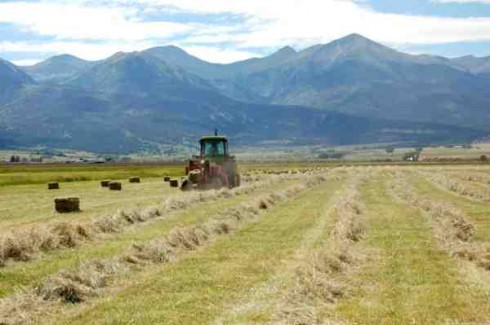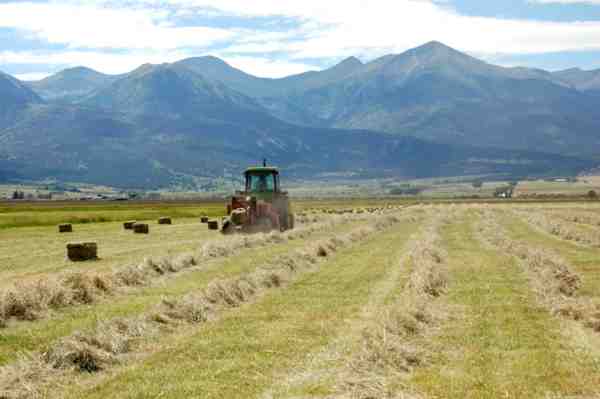Article by Shanna Lewis
Agriculture – August 2008 – Colorado Central Magazine
AN OLD ADAGE says it’s wise to make hay when the sun shines, and last year ranchers in the Wet Mountain Valley did just that. Starting in June, after a snowy winter and wet spring and summer, tractors rolled out into acres of lush grass. Verdant swaths crisscrossed the Valley floor and sweet clover perfumed the air. Soon huge silver-tarped stacks of bales sprouted along the county roads and the dark echoing hay sheds filled up. It was a good year.
In fact, it was a great year. Losses were down and production was up. “This year’s been fantastic. Excellent hay this year — good thick quality hay. This is the best year we’ve had in a while,” said hay producer and lifelong Valley resident Roger Camper.
But making hay for a living isn’t easy, even when the weather co-operates. Hay producers are constantly balancing all kinds of variables. Besides dealing with nature they are affected by changes in the economy, social issues, and even global politics (if it affects the price of oil).
The cycle of haying begins in the fall when the rancher makes decisions about fertilizing and equipment purchases. Repairs and maintenance are taken care of during the winter and for many hay producers there are cattle to look after, too. Irrigation starts in the spring. There’s always plenty of work to do around a ranch but when the grass matures and the first meadows are ready to cut, it turns into non-stop activity seven days a week.

Once the hay is cut, it’s left to cure for a couple of days. Next it’s raked into windrows and baled later that same day. Bales need to be picked up and stacked before night. To get the highest quality hay, the kind that can be sold to horse owners along the Front Range, the hay has to be kept dry.
Surrounded by the rugged granite peaks of the Sangre de Cristos to the west and the rolling Wet Mountains to the east, the Wet Mountain Valley can present some challenging climatic conditions. So, the ranchers are always concerned with the weather.
“You hope that Mother Nature dumps enough snow and rain up in those mountains so you can get the water when it’s your turn to irrigate the crops,” said Camper, “then, if you don’t have the luxury of having a barn, you have to have tarps and the wind comes up and rips the tarps and blows them off. So there’s always something you’re cussin’ about the weather. But it’s just part of it, no big deal.”
Deciding when to cut and when to wait can be difficult. The window of time available to get good hay harvested is limited, but keeping the bales dry is critical, too. “The hardest thing is when you see those rain clouds starting to build up and you are trying to get your crop in,” said Arlene Degree. She and her husband Robert work along with Robert’s brother and sister-in-law, Jerome and Carol, on the ranch that has been in the Degree family for more than 100 years.
IT CAN BE NOISY out in a hay field, as tractors and bale wagons rumble by. If that clatter suddenly stops it’s likely that the rancher, wearing grease up to his elbows, will soon be working to get some piece of equipment running smoothly again. Keeping the specialized equipment needed for haying functioning is an important part of the equation. Breakdowns happen regularly and when a critical piece of equipment isn’t running it can shut the whole operation down. Most ranchers are also mechanics on some level, so they can make repairs out in the field if necessary. They all say that fixing things is an inevitable part of hay production. Especially since replacing old machinery with new isn’t always an option.
“This equipment has gotten really, really expensive. We’d like to be a lot more modern than we are but when you’re talking $75,000 to $125,000 for a piece of equipment and then you use it for six weeks or three months and it sits in the shed for nine months — it makes it tough, unless you’re a corporation or something, to keep going. You see very few of the younger people in the ranching business anymore. For somebody young to start, unless they have someone behind them, it’s almost impossible for them to get started,” said Robert.
Oil prices have to figure into a rancher’s calculations for the year, too, because there’s a lot of petroleum products used in haying. It all adds up according to rancher Mike Shields. “Our input cost for this year is more than last year because diesel has gone up, grease, oil and the price of steel has gone up, so the parts you use have gone up. Even the baling twine is plastic, so its an oil product and that’s been affected,” he said. Mike’s wife Sara agrees, noting, “whether you’re going to use an organic fertilizer or a chemical fertilizer is dependent on the petroleum cost right now.”
Over the years hay producers have gotten more reliant on the machinery. “It’s gotten harder to hire people; it’s gotten harder to find people that know how to hay. So you’ve become more shorthanded but you have to do more so you can get your bills paid. So the equipment has had to keep up with it,” said Mike Shields.
On the San Isabel Ranch where Sara grew up, the Shields feed their cattle using small rectangular bales that weigh around 60 pounds each. These bales are the same type that are produced for use on horse farms because individuals can handle them on their own. But a lot of cattle ranchers have started using the large round or square bales that can weigh hundreds of pounds and require special equipment to transport, because the machinery makes it possible for a rancher to feed his livestock quickly without help. “We’re going to have to switch in future years,” said Mike. “We’ll have to change our haying operation where it’s not so labor intensive to feed. It’s getting down to where it’s just Sara and I. Small square bales take a lot of labor. I’m so glad when haying season is over. Then I look at all this hay sitting in these nice big old stacks and a sense of depression comes over me because I realize I have to pick up every one of these bales by hand and probably handle it two or three times.”
Shields said it all comes back to lack of help. There aren’t many people who have ranch experience and if he can find them he has a hard time offering a competitive wage. “You can make a whole lot more over in the gas fields on the western slope. Well, I can’t pay that kind of money,” he said.
Because of the difficulty finding help a lot of hay operations are pretty much family affairs. Robert Degree said, “It used to be when my dad and uncle ran it they had three or four hired men but they used horses and teams. Now, it’s tough to find anybody because you’ve got to have workman’s comp, social security and insurance for them. When you figure all that in you’d be working for them instead of yourself. So what we don’t get in, we don’t get in. It’s just one of those things.”
RANCHERS TAKE A LOT of pride in what they do. “It’s not an eight to five job,” said Mike Shields. “It’s all up to you. What happens out here is entirely on your shoulders you can’t blame it on anyone else. It’s also nice to only answer to yourself, but at the end of the year you have to say either I did a good job or I didn’t.”
Ranchers also care about the land they work. “We are stewards of this ground. We can’t afford to abuse it. I think some people might get the misconception that our grazing practices or what we do is an abuse to ground or to nature. It’s exactly the opposite. We use it to enhance what nature can do because if we don’t work with nature then we’re out of business,” said Mike Shields.
Ranchers can work with nature, but nature’s not all they have to contend with. Hay broker Bob Fulton travels across Colorado to pick up and deliver hay. He’s seen a lot of changes in the landscape. “We’re losing lots of hay ground in this state to development. Right here in our own valley too. It’s no secret that it’s a beautiful place with beautiful scenery and folks want to build houses on that wonderful hay ground. I’ve seen that happen on the western slope where they’ve already lost a lot of it to five acre tracts,” he said.
Despite all of the challenges, long hours, and hard work ranching entails, most ranchers wouldn’t trade it for anything else. “Seeing how the mountains change depending on what field you are in and the season. August light is so much different than July light or September light. The light, the hues and the colors become so much richer and deeper as the summer goes on. You get to be a part of that every day. You don’t miss out on that because of the job you have. You get to see that transformation of color and the changing seasons,” said Sara Shields.
Shanna Lewis is a staff writer and photographer for the Wet Mountain Tribune in Westcliffe and an independent radio producer. An earlier version of this article won a first-place award from the Colorado Press Assocation.


